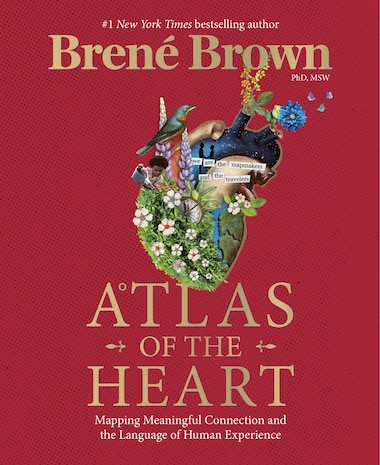
I picked up Atlas of the Heart a few months ago because I’d heard so much about her work on Kimberley Quinlan’s podcast, Your Anxiety Toolkit. Kimberley often references Brené’s work on imperfection and vulnerability.
I was struck by the elegant red cover with a floral variation of the anatomical heart, with gold lettering. It is pleasing to look at and I was eager to read into her wisdom.
The book is virtually a dictionary of definitions and examples of human emotions. The specific yet simplistic and relatable way Brené writes this piece of work makes it easy to read from cover to cover. Although it is almost entirely academic and educational, it has a smoothness to it that feels less textbook-like.
Atlas of the Heart is divided into 13 chapters, each describing clusters of emotions for different experiences. For example, chapter nine is titled “Places We Go When We Search for Connection”, and the accompanying list of experiences include: Belonging, Fitting In, Connection, Disconnection, Insecurity, Invisibility, and Loneliness.
It’s also beautifully illustrated by Gavin Aung Than. The artwork gives a beautiful aesthetic to the book and makes it feel less formal in a way.
Her work gives meaning and language to complex and nuanced emotions– such as the difference between guilt and shame, joy and happiness, and contempt versus disgust. It opened my eyes to vastness of the human experience, and how learning to describe it effectively can enhance our ability to embody the variety and diversity of emotions, outside of sad, mad and happy. As she describes it on page xxi; “Having access to the right words can open up entire universes.”
I read this book over the span of about three months, as I am a multi-book-at-a-time reader, but you could easily finish this one in a few days without getting overwhelmed by the information. Ratings by category are as follows:
Readability: 9/10
Relatability: 10/10
Practicality: 9/10
This is a great read for those wanting to expand their emotional vocabulary and improve their relationships with others by utilizing the gift of language that Brené provides.
My personal reflections from the book are mentioned below:
A key point that I underlined from Atlas of the Heart was from Chapter 1: Places We Go When Things Are Uncertain or Too Much. On page 11, Brené says, “Avoidance will make you feel less vulnerable in the short run, but it will never make you feel less afraid”.
I really identified with that. As someone who struggles with OCD and anxiety, the short-term antidote to distress is avoidance, in which our anxiety almost immediately dissipates at the relief of not having to do the hard thing at all. However, it never brings us any closer to being able to do the challenging thing that we’re avoiding, therefore keeping us stuck in a cycle of resistance.
The second sentence I marked was on page 46 in Chapter 3: Places We Go When Things Don’t Go as Planned. She writes, “It’s dangerous to put your self-worth in other people’s hands….no matter what you do you can’t control other people’s responses.”
About a year ago, in 2021, I graduated from my intensive outpatient OCD program and into individual therapy. To my surprise, we focused on schema work, instead of ERP (Exposure and Response Prevention– the typical treatment for OCD). After taking a long quiz to identify my schema, we landed on Enmeshment.
The enmeshment schema involves being completely wrapped up in the life of another. In my case, it’s my parents. So when I read Brené’s sentence, it hit home. I can’t even count the number of times I’ve felt at such a crossroads between choosing what I wanted, or choosing what my parents wanted for me, because I was desperate for their approval. I will say, almost every time I went with what my parents wanted, I betrayed myself and often ended up sicker.
Finally, I scribbled underneath the following words from Chapter 9: Places We Go When We Search for Connection, page 179. “Denying you feel lonely makes no more sense than denying you feel hungry.”
This brought me back to my senior year of high school, in which I struggled with an eating disorder AND extreme loneliness. So really I was denying myself of both of these sensations.
I remember Googling “best jobs for introverts”, and fully convincing myself that I would somehow get through life without needing anyone, ever. Funny thing is, there are virtually zero professions that actually don’t require anyone else’s involvement. People are everywhere, so we can either go on pretending they aren’t necessary to us, or we can accept that no one (that I know of) is the exception to rule that humans rely on one another to survive.
Thank you for taking the time to read my review, and please email or message me on Facebook or Instagram if you’d like to talk more about this book together!
Email: griffithskalyn@gmail.com
Facebook: Kalyn Griffiths
Instagram: @beautyreflectshealth